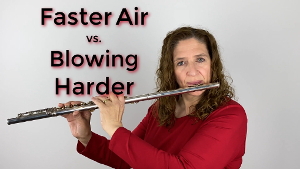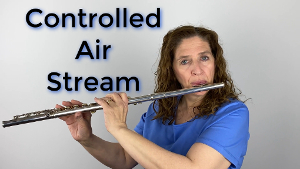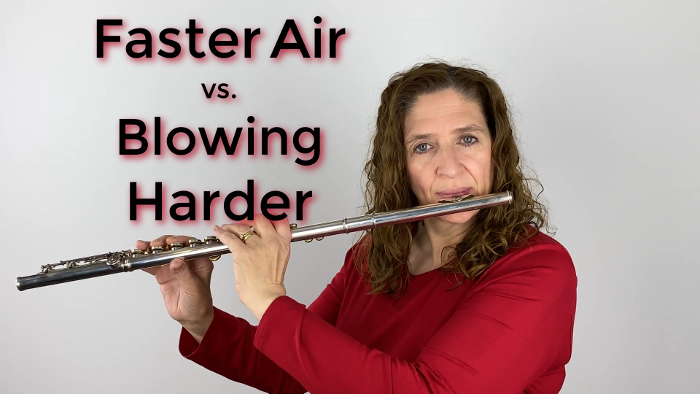What really is faster air? Isn’t blowing hard the same thing? The answer to that is a resounding maybe!
Or perhaps a weak it depends. Should they be the same thing? I can definitively say no they should not be the same thing. But sometimes they are the same, based on your interpretation.
Blowing harder is what every beginner student does in every register. They use too much air blowing and consequently get a bit dizzy from too much oxygen to the brain. Do you remember getting dizzy when you were learning the flute?
As you get older, regardless of private lessons, you usually learn to adapt to the amount of air needed. Generally, the 3rd octave gets way too much air. When this happens, the embouchure has to compensate for that amount of air, by becoming very small and tight. Yes, your 3rd octave will respond. But what are the problems? The tone is thin, the dynamic range is small and there is no color change that can happen.
High note success is built on fast air and a relaxed embouchure all wrapped up together.
The key to all high notes is the trilogy of embouchure, support, and air speed. The embouchure has to stay open, loose and remain free of tension. When support is then added, the embouchure is free to stay open and the air speed can quicken and stay steady. The problem is that students have difficulty making this trilogy work together. The result is faster air becomes blowing harder which then necessitates the embouchure to tighten to control that air. It is a sticky wicket!
Have your teachers used the term faster air? The term is usually used when referring to the speed of air needed in the 3rd octave. The speed of the air needs to increase in order for the 3rd octave notes to come out. If the air stream is not a certain speed, you will only get notes from the lower two octaves. Faster air is needed to maintain a steady 3rd octave note. We do not want to change that fast air to blow hard – as blowing hard indicates a lot of air expelled with no control except with a tight embouchure.
In truth, I do not use the term faster air, nor do I use the term blow harder on a regular basis. When I use the term faster air with younger students, their response is to blow harder. I don’t want them to blow harder, but they don’t know what fast means.
Another thing that a young student will do if you tell them to use faster air is they will blow harder and pinch the embouchure. It does produce a purer sound, so they think that is great! But because it is such a small hole that the fast air is going through, all they can get is a tiny sound. The dynamic levels are very limited from a forte to a piano.
High note production must have the embouchure be open. It must have a lot of air pressure pushing up on the high register so that your embouchure can stay relaxed. If you do not have support (air pressure) then your only recourse for control is for the embouchure to shrink. It is going to get tiny and tight.
I know that as you get higher your embouchure does shrink, but you know what? I am never going to say that to a student, because if I do, they will go to the extreme. They will concentrate so much on their embouchure that it will get small and tight. However, if I tell them to keep it open, just make the air faster and use a good push from support, then generally they do the correct amount of everything.
Experiment with blowing harder and keeping your embouchure open. Do you like what you hear? Probably not. When you blow harder you do not have any control. This is why everybody tightens up when they blow harder. The good stuff happens when you keep that embouchure from shrinking because you use so much support. You know what will naturally happen? Faster air. It will naturally happen. But if your high notes want to go low, think a little faster and that problem will go away. Can I control that air? Absolutely! Because of that air pressure, your embouchure is free to control forte and piano.
Practice in front of the mirror to see if you are pinching. You can identify if your embouchure is tight. Does it look like you do when you have a natural closed mouth position? You do need to change your embouchure, but can you keep it as natural as possible?
Sometimes I like the term “intense” to better describe the air stream for high notes. If I use the term intense air stream, then we can take the “faster” and “blowing harder” out of the equation.
So, your job is to find out if you are blowing harder, or if you are using faster air. If you are blowing harder, you can tell because blowing harder means you have to pinch. If you use the faster air stream or a more intense air stream and a lot of support pushing through there and keeping your embouchure as open as you can, then your sound can be beautiful. It can come out free and unencumbered because there is nothing that is pinching it.
If you are blowing harder, there is no control except to pinch. Use the mirror. The mirror will tell you. But some of you already know, when you play high notes for too long, then your embouchure starts getting tired. If it gets tired, you know that you are doing it wrong. Barring a few really long high pieces, I probably could play all day long without my embouchure getting tired. The only thing that gets tired are my arms holding my flute up.
Is blowing harder your problem? Are you pinching when you play or are you staying open with that relaxed embouchure making your air stream a little bit more intense?
Have fun!
DoctorFlute
In this video I will teach you how to use faster air to gain the high register with control and without blowing harder or tightening your embouchure.
Join me and watch as I explain how create the tone you want using faster air:
Faster Air vs Blowing Harder on the Flute – FluteTips 128

Controlled Air Stream on the Flute – FluteTips 129

Finding Color in Your Musical Line – FluteTips 146

